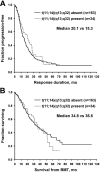Clinical implications of t(11;14)(q13;q32), t(4;14)(p16.3;q32), and -17p13 in myeloma patients treated with high-dose therapy
- PMID: 15976175
- PMCID: PMC1895302
- DOI: 10.1182/blood-2005-04-1411
Clinical implications of t(11;14)(q13;q32), t(4;14)(p16.3;q32), and -17p13 in myeloma patients treated with high-dose therapy
Abstract
Fluorescence in situ hybridization (FISH) is more sensitive than conventional cytogenetics for recognizing chromosomal changes. Several FISH-detected abnormalities have been associated with inferior prognosis, including deletion of chromosomes 17 and 13 (Delta13) and t(4;14)(p16.3;q32). We analyzed the prognostic value of FISH testing in 238 patients who received high-dose therapy between January 1990 and September 2001. All patients had pretransplantation cytoplasmic immunoglobulin FISH done on cytospin slides from bone marrow aspirates for t(11;14), t(4;14), and -17(p13.1) (TP53). Time to progression and overall survival were significantly shorter for patients with t(4;14) and those with -17(p13.1) but were not affected by t(11;14). Overall survival was significantly shorter for patients with both t(4;14) and Delta13 abnormalities than for those with Delta13 alone (26.8 vs 18.8 months). In a multivariable analysis of the effect of Delta13 and t(4;14), the risk ratio for t(4;14) was greater than for Delta13 (2.6 vs 1.5). For high-dose therapy patients, -17(p13) and t(4;14) have clinical importance for estimating time to progression and overall survival. The presence of t(4;14) identifies a subset of patients whose time to progression is only 8.2 months. These patients receive minimal benefit from autologous stem cell transplantation and are candidates for novel therapeutic approaches.
Figures



References
-
- Poulsen TS, Silahtaroglu AN, Gisselo CG, Tommerup N, Johnsen HE. Detection of illegitimate rearrangements within the immunoglobulin light chain loci in B cell malignancies using end sequenced probes. Leukemia. 2002;16: 2148-2155. - PubMed
-
- Garand R, Avet-Loiseau H, Accard F, Moreau P, Harousseau JL, Bataille R. t(11;14) and t(4;14) translocations correlated with mature lymphoplasmacytoid and immature morphology, respectively, in multiple myeloma. Leukemia. 2003;17: 2032-2035. - PubMed
-
- Avet-Loiseau H, Garand R, Lode L, Harousseau JL, Bataille R, Intergroupe Francophone du Myelome. Translocation t(11;14)(q13;q32) is the hall-mark of IgM, IgE, and nonsecretory multiple myeloma variants. Prepublished on October 3, 2002, as DOI 10.1182/blood-2002-08-2436. - DOI - PubMed
- (Now available as Blood. 2003;101: 1570-1571.) - PubMed
-
- Soverini S, Cavo M, Cellini C, et al. Cyclin D1 overexpression is a favorable prognostic variable for newly diagnosed multiple myeloma patients treated with high-dose chemotherapy and single or double autologous transplantation. Prepublished on May 1, 2003, as DOI 10.1182/blood-2002-12-3789. - DOI - PubMed
- (Now available as Blood. 2003;102: 1588-1594.) - PubMed
Publication types
MeSH terms
Substances
LinkOut - more resources
Full Text Sources
Other Literature Sources
Medical
Research Materials
Miscellaneous

